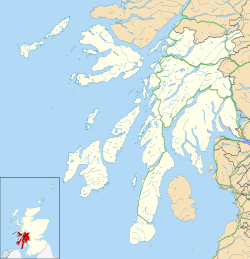
The Harrier, informally referred to as the Harrier jump jet, is a family of jet-powered attack aircraft capable of vertical/short takeoff and landing operations (V/STOL). Named after a bird of prey, it was originally developed by British manufacturer Hawker Siddeley in the 1960s. The Harrier emerged as the only truly successful V/STOL design of the many attempted during that era. It was conceived to operate from improvised bases, such as car parks or forest clearings, without requiring large and vulnerable air bases. Later, the design was adapted for use from aircraft carriers.
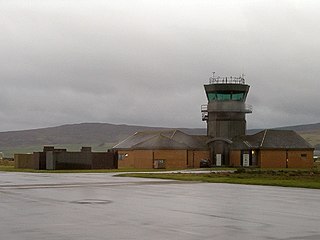
Royal Air Force Machrihanish or RAF Machrihanish is a former Royal Air Force station located near the town of Machrihanish and 3.5 miles (5.6 km) west of Campbeltown, at the tip of the Kintyre peninsula, Argyll and Bute, in Scotland.

Loch Long is a body of water in Argyll and Bute, Scotland. The Sea Loch extends from the Firth of Clyde at its southwestern end. It measures approximately 20 miles in length, with a width of between one and two miles. The loch also has an arm, Loch Goil, on its western side.
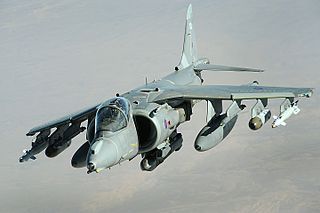
The British Aerospace Harrier II is a second-generation vertical/short takeoff and landing (V/STOL) jet aircraft used previously by the Royal Air Force (RAF) and, between 2006 and 2010, the Royal Navy (RN). The aircraft was the latest development of the Harrier family, and was derived from the McDonnell Douglas AV-8B Harrier II. Initial deliveries of the Harrier II were designated in service as Harrier GR5; subsequently upgraded airframes were redesignated accordingly as GR7 and GR9.

Royal Air Force Barkston Heath or RAF Barkston Heath is a Royal Air Force Relief Landing Ground under the command of RAF Cranwell near Grantham, Lincolnshire, England.
Royal Ordnance Factories (ROFs) was the collective name of the UK government's munitions factories during and after the Second World War. Until privatisation, in 1987, they were the responsibility of the Ministry of Supply, and later the Ministry of Defence.

Royal Air Force Welford or more simply RAF Welford is an active Royal Air Force station in Berkshire, England. The station is located approximately 6 miles (9.7 km) northwest of Newbury; about 50 miles (80 km) west-southwest of London

The Royal Navy Propellant Factory, Caerwent was a facility at Caerwent, Monmouthshire, Wales, UK, which was originally dedicated to the manufacture and storage of Royal Naval munitions. Since its closure as an armament works in 1966, it has been used by the US military and the British Army. It is now used as the Caerwent Training Area. A new purpose-built military barracks is set to be built on the site to house 1st The Queen's Dragoon Guards and 1st Battalion, The Rifles from 2027.

Royal Naval Armaments Depot Coulport, shortened to RNAD Coulport, on Loch Long in Argyll, Scotland, is the storage and loading facility for the nuclear warheads of the United Kingdom's Trident programme.
11 Explosive Ordnance Disposal and Search Regiment RLC is a specialist regiment of the British Army's Royal Logistic Corps (RLC) responsible for counter terrorist Explosive Ordnance Disposal (EOD), the safe recovery or disposal of conventional munitions. The regiment also has an ammunition inspectorate role supporting the Inspector Explosives (Army). With headquarters in Didcot, the regiment has sub units geographically based throughout the UK to provide a nationwide high readiness response capability in support of the police.
The Defence Explosive Ordnance Disposal, Munitions and Search Training Regiment is an element of the Royal School of Military Engineering responsible for the delivery of training to British Army Ammunition Technicians, Ammunition Technical Officers and Search Operators. The Regiment delivers training from two locations: Marlborough Barracks, MoD Kineton near Kineton, Warwickshire and St George's Barracks, MoD Bicester, near Bicester, Oxfordshire.

Defence Equipment and Support (DE&S) is a trading entity and joint-defence organisation within the UK Ministry of Defence. It began operating on 2 April 2007, following the merger of the MoD's Defence Procurement Agency and the Defence Logistics Organisation, under the Chief Executive Officer of Defence Equipment and Support.

A Royal Naval Armament Depot (RNAD) is an armament depot dedicated to supplying the Royal Navy. They were sister depots of Royal Naval Cordite Factories, Royal Naval Torpedo and Royal Naval Mine Depots. The only current RNAD is RNAD Coulport, which is the UK Strategic Weapon Facility for the nuclear-armed Trident Missile System; with many others being retained as tri-service 'Defence Munitions' sites.
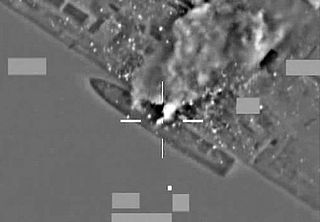
Operation Ellamy was the codename for the United Kingdom participation in the 2011 military intervention in Libya. The operation was part of an international coalition aimed at enforcing a Libyan no-fly zone in accordance with the United Nations Security Council Resolution 1973 which stipulated that "all necessary measures" shall be taken to protect civilians. The coalition operation was designated by NATO as Operation Unified Protector, by the US as Operation Odyssey Dawn. The Canadian participation as Operation Mobile and the French participation as Opération Harmattan. It was confirmed in December 2011 that the cost of the operations was £212m – less than was estimated, including £67m for replacing spent munitions, is all expected to be met from the Treasury reserve.
Defence Munitions Crombie is a military munitions depot on the upper Firth of Forth in West Fife, Scotland. The depot is located on the north shore of the river, south of the village of Crombie and west of Charlestown. The site commenced operations in 1916. It was formerly known as RNAD Crombie and DMC Crombie. It is now operated as part of the UK's Defence Storage and Distribution Agency.
Defence Munitions Gosport is a defence munitions site situated on the southwestern shores of Portsmouth harbour, southeast of Fareham in Hampshire, England. The site occupies about 470 acres. Its facilities include two Integrated Weapon Complexes (IWCs), 24 processing rooms and 26 explosives stores. The site employs some 270 staff.
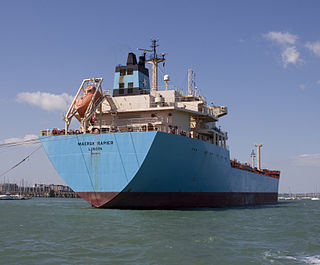
MV Maersk Rapier is a commercial product tanker that was owned by the A.P. Moller–Maersk Group and chartered to the United Kingdom's Ministry of Defence (MoD). The vessel served as the primary strategic link for the collection and transportation of purchased fuel from oil refineries to British and NATO fuel depots.

The Defence Armament Depot, named the Kauri Point Armament Depot until 2010, is a New Zealand Defence Force munitions storage facility in the Auckland suburb of Chatswood which was originally built for the Royal New Zealand Navy. The Depot has access to Waitematā Harbour. The armament depot was established in 1935, and was considerably expanded during the Second World War. A program to modernise the facility was announced in 2011.

Exercise Joint Warrior is a major biannual multi-national military exercise which takes place in the United Kingdom, predominately in north west Scotland. It is the successor of the Neptune Warrior exercises and Joint Maritime Course.

The United Kingdom Carrier Strike Group 21 (CSG21) was a British-led naval force that was deployed on Operation Fortis from May to December 2021. The Carrier Strike Group is seen as the beginning of the British Government's tilt towards the Indo-Pacific region in terms of defence and foreign policy, that had been announced in March through the Integrated Review. It was the first strike group deployment for the Queen Elizabeth-class aircraft carriers, and the first operational deployment of the UK Carrier Strike Group since 2011. The deployment was the largest single deployment of F-35 fighter aircraft since the programme started in 2006, and the largest fifth-generation fighter carrier air wing in the world at the time. Furthermore, HMS Queen Elizabeth saw the largest number of personnel embarked since she entered service, and the group contained the largest number of Royal Navy maritime helicopters deployed in over 10 years.

